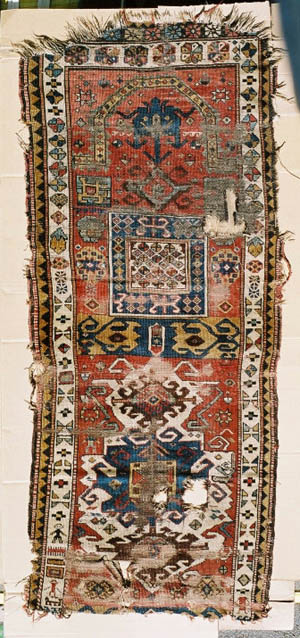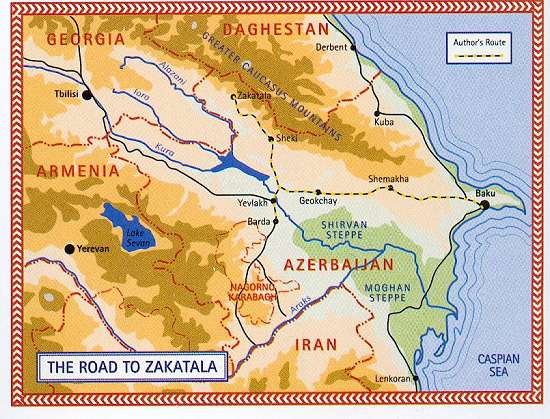Posted by Lloyd Kannenberg on 12-03-2004 02:37 PM:
Rug for Identification
Hello All,
Here's a piece that qualifies as a ruin in anyone's
book:

But
it's an interesting ruin, I think. It has elements reminiscent of Plate 14 in
"Through the Collector's Eye" - a magnificent NON ruin! I think my example may
have started life as a runner. Can anyone shed some light on its place of
origin? People much more knowledgable than I have suggested Zakatala, Eastern
Anatolia, Kurdish. For the record, the warps are slightly, but not clinically,
depressed.
Lloyd Kannenberg
Posted by R. John Howe on 12-04-2004 07:37 AM:
Lloyd -
The best person, likely, to speak to your piece is Ralph
Kaffel, who sometimes watches this site and is willing to comment.
I
really know nothing in particular about Caucasian prayer rugs but notice some
things about this fragment.
First, it would be useful to know its size as
it stands. From the shape it appears that it could be quite long. In his book,
Kaffel shows some prayer rugs that are longer than use in prayer would require.
He shows three long Peripedils, the longest being 8'5". Two of them have niche
designs at both ends. The designs of the Peripedils do not resemble the rather
odd amalgam on your piece.
Second, your piece exhibits a cross panel.
This happens in Turkmen engsis and in some Turkish rugs but Kaffel says it is
unsual in Caucasan prayer rugs. He shows only one, Plate 35 with a cross panel,
but that piece does not in other ways resemble yours either. And the cross panel
on Plate 35 occurs at the end of the field while yours is midfield.
I am
not sure that we can say anything on the basis of the niche form on your piece
but I notice that it is curved and that it floats. This is a usage that looks as
if it could have been added for marketing purposes (apparently Caucasian weavers
discovered that niche designs were popular and began to add them sometimes for
that reason alone) to a design that was complete without it.
The fact
that the various designs in this piece appear not to have much integration (as
if they were taken from different rugs) is odd and one wonders what the missing
end looked like, e.g. was there another nich form?
I also looked through
Peter Stone's new book on tribal and village designs to see what help he might
offer.
The lower half of your piece has some usages that seem similar to
what Stone calls Kazak medallions. There may even be traces in some areas
(although they are not well drawn) of "pinwheel" usages.
The blue device
under the niche seems similar to what Stone calls a Karagashli variant of a Kuba
medallion although the downward pointing arrows are not part of what Stone
provides. It is the internal tree-like instrumentation that is apparently the
hallmark of this usage.
The rectangular device with the white ground
interior resembles (although the devices in it seem very conventialized) some
Daghestan and Shirvan field repeats. Color seems not to be used diagonally in
these field devices.
The border seems also an amalgam of conventionalized
devices of various sorts. I think I see the remains of bracketing devices one
encounters in kufic borders.
One suspects several weavers working perhaps
in sequence over time and largely ignoring what had been done before.
It
is an interesting and unusual piece.
Regards,
R. John Howe
Posted by Filiberto Boncompagni on 12-04-2004 11:43 AM:
Yes, that’s another interesting one.
It could be a Zakatala. According
to the article “On the road to Zakatala” (Hali 78), Zakatala rugs have “longish
pile, relatively coarse weave, multiple naturally-colored dark woolen wefts,
subdued mellow tonality… and a range of design drawn from the varied vernacular
traditions that come together in Azerbaijan, some said they were Kurdish, others
that they were made by Turks who had moved to Zakatala from the Konya region in
the 19th century, but no one really knew.”
Foe sure, ethnically speaking, the
Zakatala region is a melting pot inside the wider Caucasian melting pot and the
designs they used reflect this fact…
Any multiple brown wefts in your
rug?
Regards,
Filiberto
Posted by R. John Howe on 12-04-2004 02:42 PM:
Dear folks -
I'm not sure but I think the Zakatala attribution might
be one of those more readily pinned down.
Zakatala rugs were only
distinguised quite recently and I think one of the important criteria seems to
be that many "Zakatala" pieces have wool that is S-spun rather than
Z-spun.
Regards,
R. John Howe
Posted by Jerry Silverman on 12-04-2004 05:14 PM:
...a Kazak version of a "vagireh"? 
It's got damn near all the
signature Kazak motifs. Especially if the missing bottom portion that John
wonders about has a nice "crab" border.
Cordially,
-Jerry-
Posted by R. John Howe on 12-04-2004 05:59 PM:
Hi Jerry -
That would be interesting: a long Caucasian
sampler.
Gordon Priest, a collector from Baltimore, did the TM rug
morning today and started with four samplers all Persian.
Gordon also had
two pieces with the diamond device that occurs in this narrow border. One he
said was Kuba, the other Shahsavan. Of course, these borders have lots of things
in them.
It could be that this piece had more design regularity than
might seem to be the case at first. That's one of the reasons I asked how long
this fragment is. It seems like we can see the beginning of a second cross panel
colored and with devices much like the first.
Could it have finished like
it starts?
If so, I'd guess it was a pretty long
piece.
Regards,
R. John Howe
Posted by Patrick Weiler on 12-05-2004 02:50 PM:
Lloyd,
The "anchors" of the large white medallion near the bottom of
your rug have a striking similarity to this eastern Anatolian Kurdish yastik.
Both have brown latchook devices at either end of the medallion.
In your rug,
the latchook diamonds are internal to the anchors, but in my yastik, they are
outside the anchors. The latchooks look a lot alike, due to the less than
perfect drawing (spontaneous? crude? rustic?) the same brown color and their
location at the ends of the medallion.

These kinds of features may have
been suggestive of an eastern Anatolian/Kurdish origin for your rug to some of
those who have seen it, but the colors of your rug do not appear to be anything
like eastern Anatolian.
The large-tailed confronting creatures in the
"cross panel" are quite intriguing. It appears that there was another identical
"cross panel" at the bottom of the rug, as John Howe indicated. I wonder if
Vincent can mirror-image your rug so we could see what it might look like if, in
fact, the white medallion was in the center of your rug and it is missing only
the bottom end?
As the author/moderator of the Salon, I believe I get to
select one of the pieces shown during the discussion. Your rug is at the top of
my selection list....

Patrick Weiler
Posted by R. John Howe on 12-05-2004 02:59 PM:
Hi Pat -
I'm not sure, but I think the devices in the cross panels
are, in external outline, a version of the "hexagon with externally oriented
rams horns" device that Peter Davies discussed at the TM recently.
The
internal instrumentation is anything but Anatolian, though.
It likely is
an instance showing again that various "Turkic" devices were used
broadly.
Regards,
R. John Howe
Posted by Patrick Weiler on 12-05-2004 07:56 PM:
Sauropods
John,
The cross-device certainly conforms to a "hexagon with
externally oriented rams horns". It is the pregnant sauropods inside the
hexagon, to either side of the vertical hexagon in the middle of the larger
cross-piece hexagon I am intrigued by.
http://www.heureka.fi/exhibitions/dino/apato2.html
Perhaps
there was a Caspian Creature, similar to the Loch Ness Monster, that the weaver
had seen. Did Mr. Davies discuss the motifs inside the hexagons?
Patrick
Weiler
Posted by Lloyd Kannenberg on 12-05-2004 08:44 PM:
Dear All,
Thanks to everyone for your kind comments!
In answer
to questions, here is some technical data on the rug. Width 3 feet 2 inches,
length (at present) 7 feet 6 inches. Wefts are mostly dark brown, with some
light brown and at the very bottom some red. The are two or four weft shoots
between knot rows, two shoots predominating. The warps are Z spun, 2S
plied.
The blue and yellow horizontal band just below the square device
in the field is repeated at the bottom (you may be able to see its beginning at
the lower end of the picture). Since it is about 4 feet 3 inches from the upper
band to the top of the rug, a symmetrical continuation below the lower band to
the now missing bottom would mean that the original rug was about 11 feet 9
inches long - a pretty respectable size.
Since the "Zakatala" attribution
has come up, maybe someone can help me locate the place. Nearly all the maps I
have seen locate it in northwest Azerbaijan, nearly in the Caucasus main chain.
On the other hand, in Mr. Burns's excellent book on Kurdish rugs his map locates
"Zakataly" just east of Mount Ararat (Agri Dagh). Hovannissian's "History of
Armenia 1918-1920" has several maps of this area, showing many villages, none
identified as "Zakatala" or "Zakataly". Could it be that there was such a
village in that area which no longer exists, or was renamed? Or is it possible
that Zakatala and Zakataly are one and the same town in northeast Azerbaijan
after all?
Lloyd Kannenberg
Posted by R. John Howe on 12-05-2004 11:14 PM:
Mr. Kannenberg -
In his Lexicon, Peter Stone offers both the spellings
you cite above and says that they are a "group of villages of northern
Azerbaijan in the Caucasus."
Their rugs he says are "all wool,
symmetrically knotted" and "have designs of vertical stripes or variations of
Kazak designs."
Regards,
R. John Howe
Posted by Filiberto Boncompagni on 12-06-2004 04:38 AM:
Zakatala (also spelled Zakataly) is the name given to both the district and
the main town. The district is in Northern Azerbaijan, is composed of around
fifty villages and had a population of about 100,000 of whom 60% Daghestani
(Avar, Lesghi, Zeikhuri and Kumyk), 30% Azeri, 10% of Georgian Muslims and a
former presence of Armenians which had left because of the turmoil between
Armenia and Azerbaijan. There are 28 different dialects spoken in the area.
That’s according to HALI’s contributing editor Tony Hazledine who actually
went there in 1994.
As I said, his article was published in HALI 78.
Here is a map from the article, showing Hazledine’s itinerary from Baku to
Zakatala.

Regards
Filiberto




